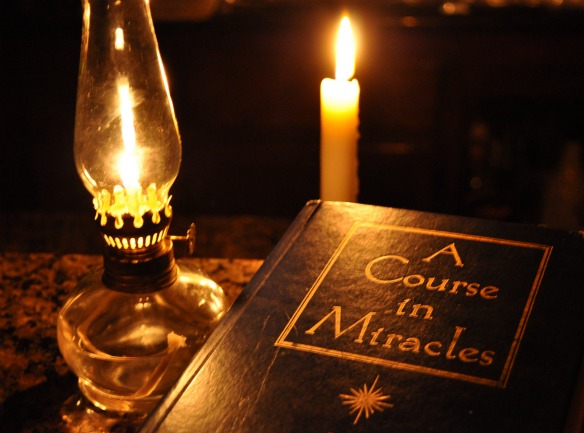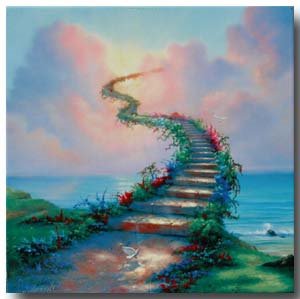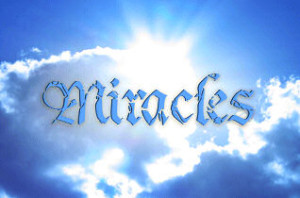by Kenneth Bok
Introduction
 In attempting to understand what A Course in Miracles is, where it came from, and most importantly, what it says, it is helpful to let go of all preconceptions about spirituality and religion. A Course in Miracles does not fit neatly into any category in this domain. The mind often tries to understand something new by comparing it to things it already knows. This is helpful to an extent, but let us be careful of trying to fit a square peg in a round role. If I had to place A Course in Miracles in a bookshop, I could put it in equally under ‘Christianity’, ‘Buddhism’, ‘Hinduism’, ‘Non-dualism’, ‘New Age’, ‘Psychology’, ‘Self-help’ or ‘Poetry’ – but in truth, such categorization would not do it justice.
In attempting to understand what A Course in Miracles is, where it came from, and most importantly, what it says, it is helpful to let go of all preconceptions about spirituality and religion. A Course in Miracles does not fit neatly into any category in this domain. The mind often tries to understand something new by comparing it to things it already knows. This is helpful to an extent, but let us be careful of trying to fit a square peg in a round role. If I had to place A Course in Miracles in a bookshop, I could put it in equally under ‘Christianity’, ‘Buddhism’, ‘Hinduism’, ‘Non-dualism’, ‘New Age’, ‘Psychology’, ‘Self-help’ or ‘Poetry’ – but in truth, such categorization would not do it justice.
The metaphysical, spiritual and psychological concepts presented in A Course in Miracles are universal. They are what they are. They do not belong exclusively to any one person, group, or body of knowledge. Although these concepts are well-illustrated in the categories listed above, the uniqueness of A Course in Miracles lies in the masterful combination, structure and presentation of these meaningful concepts.
How is it presented?
A Course in Miracles is a self-study spiritual path presented in 3 books:
The Text: A theoretical framework for the ideas of the Course
A Workbook for Students: A series of 365 lessons, to be done one per day
A Manual for Teachers: Clarifications on terms and concepts, in a Q&A format
These 3 books, together with some supplementary documents, are commonly found bound together as a single volume. The third (the most current) edition looks like this:
The Text and the Workbook go hand-in-hand, and it is essential to read the Text to build a theoretical foundation whilst doing the practical lessons in the Workbook. While not strictly necessary, it is often helpful for students to read supplementary books about the Course and/or to discuss the Course in study groups. In-line with its self-study nature, the Course is not the basis for any kind of organized religion or cult.
The Course is written largely in iambic pentameter, also known as Shakespearean blank verse due to Shakespeare’s use of it in his sonnets and plays. This form allows the text to be read in a rhythmic, living quality which is caused by the alternation of stressed and unstressed syllables. There is judicious and masterful use of alliteration, rhyme, metaphor and simile throughout the text.
What does it say?
At first glance, the Course appears Christian, because of the Christian language used – the text is peppered with terms such as ‘Holy Spirit’, ‘Atonement’, ‘Christ’, ‘Heaven’ and ‘Salvation’. However, the content of A Course in Miracles is much more similar to the Eastern Philosophies, such as Buddhism and Hinduism, and most notably to the Vedanta, a philosophy laid out in the ancient Upanishads of India.
“At the time I remember thinking that the Course could be described as a form of Christian Vedanta.”
Bill Thetford
A Course in Miracles and the Vedanta both present a non-dualistic view: God / Heaven / Brahman is all that IS, and everything else is illusion. Everything that is impermanent is illusion. Time and space, hot and cold, up and down, the world as we know it, are all manifestations of the mind and seek to keep us unaware of our true nature – that we are one with God, that we have always been and will always be.
Nothing real can be threatened.
Nothing unreal exists.
A Course in Miracles, T-in.2
***
The real does not die, the unreal never lived.
I Am That
Sri Nisargatta Maharaj
(A classic text on Advaita Vedanta, the non-dualistic sub-school of Vedanta)
Like Buddhism, the intent and structure of A Course in Miracles is deeply psychological and psychotherapeutic. An even better word, although not commonly used, would be ‘psychospiritual’. The Course uses concepts in modern psychology developed by Jung and Freud: the psychological defense mechanisms of denial and projection, the conscious and unconscious mind, and the psyche.
 However, the ego as used in A Course in Miracles, has a slightly different meaning to Freud’s Ego (From his trinity of Id, Ego and Superego). Dr. Kenneth Wapnick, the foremost scholar of the Course, defines the ego as:
However, the ego as used in A Course in Miracles, has a slightly different meaning to Freud’s Ego (From his trinity of Id, Ego and Superego). Dr. Kenneth Wapnick, the foremost scholar of the Course, defines the ego as:
the belief in the reality of the separated or false self, made as substitute for the Self Which God created; the thought of separation that gives rise to sin, guilt, fear, and a thought system based on specialness to protect itself; the part of the mind that believes it is separate from the Mind of Christ
The vedantic equivalent of the ego is Maya – the illusory power of Brahman which causes the Brahman to be seen as the material world of separate forms. Given the psychological nature of the Course, it is no coincidence that the prominent figures involved in the scribing and initial editing of the Course, Helen Schucman, Bill Thetford and Kenneth Wapnick, were all highly respected clinical psychologists – their familiarity with these concepts was essential to the message of the Course to come through accurately.
The purpose of the workbook is to train your mind in a systematic way to a different perception of everyone and everything in the world.
Introduction, Workbook for Students, A Course in Miracles
Perfect happiness is always present in us, full and complete. Our suffering and misery can be likened to clouds that obscure the sunlight – even though we sometimes cannot see the sun directly, the sun is always present. Depending on the weather conditions, we may experience the full strength of the sun, a diffuse glow in the sky or the inky darkness of a storm. The goal of A Course in Miracles is to remove these blocks to our awareness of God, Happiness and Love through healing our minds.
The course does not aim at teaching the meaning of love, for that is beyond what can be taught. It does aim, however, at removing the blocks to the awareness of love’s presence, which is your natural inheritance. The opposite of love is fear, but what is all-encompassing can have no opposite. A Course in Miracles, T-in.1.
Here, it is important to note this subtle but important distinction – A Course in Miracles is not about saying yes to Love, but about not saying no to Love. Pure and perfect Love is who We really are – there is no need to proclaim this any further. Rather, it is far more important to work on the reasons that prevent us from experiencing this state in every moment.
This work and this healing takes place through the practice of forgiveness. Indeed, forgiveness is the center of the practice of A Course in Miracles – we will accomplish nothing even if we fully understand the theory of A Course in Miracles without applying forgiveness to our everyday lives.
Again, the forgiveness that A Course in Miracles teaches is slightly different to that of the commonly understood sense of the word. ‘Course-based forgiveness’ (Robert Perry) or ‘Quantum forgiveness’ (Gary Renard) recognises that our discontent with others and ourselves stems from the unconscious agenda of the ego to maintain a sense of separation. If the world is an illusion, everything that others do unto us, are really things that we do unto ourselves. The worst of deeds are self-manifested illusions driven by the ego’s misguided need to defend itself against God. We forgive because we know that the self and the other are both wholly innocent, and in so doing, we return to our true nature – which is unity and wholeness.
We forgive others for what they have not done to us, not for what they have done
Kenneth Wapnick
Forgiveness does not mean condoning or agreeing with a horrendous act. It is a decision to no longer attack one’s self. Forgiveness is, quite simply, the decision not to suffer. To forgive is to make the decision to be happy, to let go of judgements, to stop hurting others and ourselves, and to stop recycling anger and fear. Forgiveness is the bridge to compassion, to inner peace, and to a peaceful world.
Love is Letting Go of Fear
Gerald G. Jampolsky, M.D.
The concept of forgiveness goes hand-in-hand with the concept of the miracle in A Course in Miracles. Kenneth Wapnick, defines the term miracle as such:
the change of mind that shifts our perception from the ego’s world of sin, guilt, and fear, to the Holy Spirit’s world of forgiveness; reverses projection by restoring to the mind its causative function, allowing us to choose again; transcends the laws of this world to reflect the laws of God; accomplished by our joining with the Holy Spirit or Jesus, being the means of healing our own and others’ minds.
Kenneth Wapnick, Ph.D.
Simply put, a miracle is a decision to choose the path of the Holy Spirit and to follow his guidance, against the ego’s plan of reinforcing separation.
A Course in Miracles makes no claims to being the only form of truth, or that it is the only spiritual path. Everyone has their own path, and A Course in Miracles is not for everybody. Spiritually speaking, it is a challenging but direct path. It is challenging because it involves a radical paradigm shift – not in how we live in the world, but in how we see the world. A Course in Miracles is not concerned with dealing with the symptoms of suffering, it deals with the root cause of suffering – the illusory sense of separation from God. As recognised by other practices such as Vipassana, these roots are largely unconscious. It is this recognition and effectiveness in dealing with the unconscious that sets A Course in Miracles apart from other spiritual and religious disciplines.
Where did it come from?
Helen Schucman and William “Bill” Thetford were Professors of Medical Psychology at Columbia University’s College of Physicians and Surgeons in New York City in the 1960s.
Being in a prestigious and competitive academic setting, in the midst of inter-departmental rivalry and backbiting, their professional and personal relationship was often strained and frustrating for both of them. Helen writes in her autobiography (quoted from Absence From Felicity, Wapnick):
The relationship between Bill and myself deteriorated steadily. We had become quite interdependent, but we had also developed considerable anger towards each other. Our genuine attempts to cooperate were more than offset by our growing resentments. We began to get much less work done, while experiencing greater and greater fatigue…
One day, exhausted by the negative attitudes surrounding their relationship, Bill became uncharacteristically sentimental during a meeting. He gave a speech, declaring that ‘there must be another way’. To add on to this unusual show of vulnerability and honesty, Helen agreed and was enthusiastic about finding a new approach. This is a example what the Course describes as a ‘Holy Instant’, a moment where a little willingness causes a healing change in perspective, often in the face of a situation which seems normal, logical and acceptable in an ego-dominated world.
Over the next 7 years, Helen would have a series of symbolic dreams and hear an inner voice – a mental dictation which she could start and stop at any time. She would be fully conscious while it spoke to her, and she was not in a trance or altered state. Although she was not a stranger to mystical experiences, she was initially as frightened by the experience as she was for her sanity. It was Bill, who had a growing interest in her paranormal experiences, who urged her to take down what the voice said.
Helen, a professed atheist, had no doubt that the voice was Jesus. The Course is dictated in the first person, and the identity of the author is clear from the writing – for example, in Chapter 6, Section I of the text, it speaks about and clarifies various points surrounding the Crucifixion, the Apostles, and Judas.
Undoubtedly, many people, especially traditional Christians, will have tremendous difficulty accepting this at best, with many dismissing it as some new-age spiritual hogwash. There will be certainly much doubt and debate as to whether this Jesus is the Jesus of Modern-Day Christianity. However, the voice urges us to see beyond the form and into the essence:
The Name of Jesus Christ as such is but a symbol. But it stands for love that is not of this world. It is a symbol that is safely used as a replacement for the many names of all the gods to which you pray. This course has come from him because his words have reached you in a language you can love and understand.
A Course in Miracles, M-23.4
Conclusion
We have seen a brief overview of the multifaceted aspect of A Course in Miracles, and it is clear that the Course is unique as a book as it is a spiritual path. It is precisely this multifaceted aspect of the Course, however, which causes it to be prone to misrepresentation and misunderstanding.
The Course is not an easy-read, not meant to be speed-read, and not a book to be read once and left aside. It is a manual for a lifetime’s work on one’s self. It is an unparalleled pathway for ultimate liberation. It compares with the great literary works and the great mystical traditions of the world.
Every student of the Course has a different relationship with the Course. Some people will read it to feel good. Some read it as a supplement to their existing spiritual or religious practice. Some will embrace it and make it a core of their being. If you are not a student of the Course, it is my sincere desire that the Course finds you, as it did for me, and it brings you much peace and happiness. And if you are a student, keep forgiving!




A Course in Miracles Book by Helen Schucman (Online Reading – Summary – Review – Book – Download – PDF): https://www.toevolution.com/file/view/197882/a-course-in-miracles-book-by-helen-schucman-online-reading-summary-review-book-download-pdf
The Course as it is affectionately referred too found me 9 years ago as I was going thru the discount rack at a local Barnes & Nobles book store, I was so enamored by the title of the book that I had to get a copy. I took it home and started my arc of discovery! That lead me all the way to becoming an Ordained Minister, under the guidance of The Community Miracle Center of San Francisco. I became an ordained Minister on 8/23/20, #120 to be exact, now known as Rev. AB, to say the least the Course is a Spiritual Path of Truth that I hope I will never put down and continue to learn from, there are many significant parts to the Course that I just Love and that is a very profound point! “Only the Love is Real” a statement that continues to ring true for me every day! Peace & 143 Rev. AB.